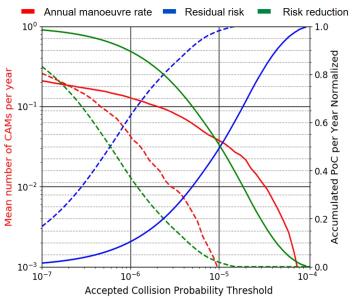Assessment of collision avoidance manoeuvre planning for low-thrust missions

Develop a tool to assess how the adoption of low-thrust propulsion affects the collision avoidance efforts
In the last years, electric propulsion has become an interesting alternative to the traditional chemical propulsion for different applications, ranging from transfers to GEO to operations of (large) constellations of small satellites in LEO.The activity will first look at available data on flown hardware and their performance, together with a review of currently adopted operational concepts. For transfers with long continued thrust phase (both in LEO and to GEO), a methodology will be defined to assess the expected alert frequency taking into account the performance of the orbit determination process and of the thrusters (e.g. in terms of accuracy in the thrust level and directions).Similarly, for Low Earth Orbit missions, the thruster performance will be evaluated to assess the resulting uncertainty evolution and derive suitable operational concepts (e.g. frequency of manoeuvre screenings).In both scenarios, in the case of close approaches, the achievable risk reduction as a function of the reaction time will be assessed. The trade-off between reaction time and threshold in collision probability level will be investigated to assess the impact of collision avoidance activities on the mission operations and the level of risk reduction that can be achieved by different low-thrust systems.The outcome of the study will be then translated into an update of the ESA DRAMA tool to facilitate the analysis of low-thrust missions, covering operations in LEO, GTO transfer, and GEO.This activity encompasses the following tasks: - Data collection on low-thrust propulsion systems and achieved performance- Analysis of uncertainty evolution in presence of low-thrust arcs- Definition of an operational concept for screening requests for collision risk assessment- Definition of an operational concept for collision avoidance manoeuvre with low-thrust propulsion systems- Sensitivity analysis on the risk reduction as a function of the accepted impact on operation- Update of ESA DRAMA tool
